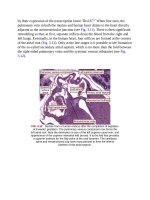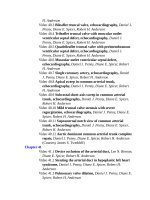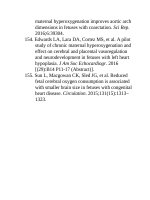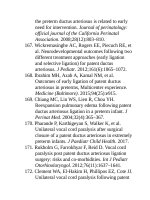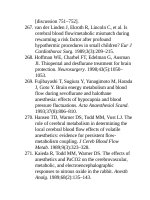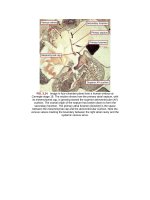Andersons pediatric cardiology 1150
Bạn đang xem bản rút gọn của tài liệu. Xem và tải ngay bản đầy đủ của tài liệu tại đây (125.24 KB, 3 trang )
beingsqueezedoutbythehugesizeofthedilatedright-sidedchambersof
theheart.Bottom,TheheartitselfhadEbsteinmalformationofthetricuspid
valve.
Thepulmonaryatresiaitselfisusuallyproducedbyanimperforatepulmonary
valve,andthepulmonaryarteriesaretypicallyofgoodsize,beingfedthrough
thepersistentlypatentarterialduct.Theproblemlieswiththetricuspidvalve,
whichexhibitseithersevereEbsteinmalformation(seeFig.43.8,bottom),or
significanttricuspidvalvardysplasia.15Theconsequenceofthegrossdilationof
theheartisthatthelungsbecomesqueezedduringfetallife,anddonotdevelop
properlyhypoplasticlungs.Allthecomponentpartsarepresent,buttheyare
unabletoexpandinappropriatefashionbecausealmostallthespacewithinthe
thoraxisoccupiedbytheheart.15ThewallsoftheRValsobecomeexcessively
thin.Suchmyocardialthinning,existingasaconsequenceofventriculardilation,
shouldnotbemisinterpretedasrepresentingtheUhlanomaly.Thelatterlesionis
theconsequenceofcongenitalabsenceofthemyocardiumintheparietalwalls
oftheRV,andisfoundwithnormaltricuspidandpulmonaryvalves.42
SegmentalCombinations
Intypicalpulmonaryatresiainthesettingofanintactventricularseptum,there
isusualatrialarrangement,withconcordantatrioventricular,andpotentially
concordantventriculoarterialconnections,withtheatreticpulmonarytrunk
arisingfromthemorphologicallyrightventricle.Inexceedinglyrare
circumstances,pulmonaryatresiacanbefoundinthesettingofanintact
ventricularseptumwhentheventriculoarterialconnectionsarediscordant.Inthis
setting,becauseofthediscordantconnections,theatreticpulmonarytrunkarises
fromthemorphologicallyleftratherthanrightventricle.Henceleftventricular
hypoplasiadominatesthepicture,typicallywiththeventriclehavinga
fibroelastoticliningasisthecaseinhypoplasiaoftheleftheartwithusual
segmentalcombinations(seeChapter69).Thisrarevariantofpulmonaryatresia
withintactventricularseptumcanbefoundeitherwithconcordantordiscordant
atrioventricularconnections.Asfarasweareaware,ithasnotbeenfoundinthe
settingofisomericatrialappendages.
ClinicalDiagnosis
PrenatalDiagnosis
Fetalechocardiographyisnowwellestablished,andithasprovedtobeeffective
atdetectingthelesion.17Casesareusuallydetectedbecauseofanabnormalfourchamberviewonechocardiography,butprenatalidentificationoftricuspid
regurgitation,andevenrecognitionofcoronaryarterialabnormalities,isnow
feasible.17,43–48OnthemainlandoftheUnitedKingdom,evenbytheearly
1990s,two-fifthsofallcaseswerediagnosedduringfetallife.19Theproportion
atthecurrenttimeislikelytobeevenhigher.Thishaschangedthenatural
historyofthedisease,leadingatleastintheUnitedKingdomtoselective
terminationofpregnancy,fetalintervention,andplanneddelivery.
PostnatalDiagnosis
Afterbirth,infantspresentwithcyanosisintheneonatalperiod,and/ora“failed”
pulseoximetryscreening.Thearterialductisthesolesourceofbloodflowtothe
lungs,althoughthischannelrarelyremainswidelypatentformorethanafew
days.Veryrarely,patientsmaybefoundwithsystemic-to-pulmonarycollateral
arteries,39,49–52butusually,assoonastheductnarrows,arterialdesaturation
increases,andvisiblecyanosisresults.Infantswithseveretricuspidregurgitation
mayalsoshowsignsofcongestiveheartfailureandrespiratorydistress.
PhysicalFindings
Theusualphysicalfindingscanbeexplainedbytheabnormalmorphology.
Cyanosishasalreadybeendiscussed.Pulsesandbloodpressurearenormal
becausesystemiccardiacoutputisnotimpaired.Thejugularvenouspulseis
hardtoevaluateinnewborns,andisnotausefuldiagnosticsign.Precordial
motionisnormalbecauseapurepressureoverloadoftheRVdoesnotusually
resultinanexaggeratedleftparasternallift.Thesecondheartsoundatthehigh
leftsternalborderissoftandsingle,orisinaudible.Thefirstheartsoundis
normal,andanejectionsoundisnotpresent.Severalmurmursmaybeheard.
Themostcommonisasofthigh-pitchedcontinuousmurmuratthehighleft
sternalborder.Thismurmuroriginatesintheduct,andisusuallyquitesubtle.
Occasionally,itmaybeheardonlyintermittently,disappearingwhentheduct
narrowsandcyanosisdeepens,andappearingagainastheductopensand
cyanosislightens.Someinfantswithpulmonaryatresiahaveasofthigh-pitched
systolicmurmuroftricuspidregurgitationatthelowleftsternalborder.The
presenceofthismurmurcorrelatesstronglywitharelativelylargeRV,53butlack
ofamurmuroftricuspidregurgitationdoesnotruleoutanRVofnormalsize.
Whenthereisseveretricuspidregurgitation,thereisoftenasoft,mediumpitched,mid-diastolicmurmuratthelowleftsternalborder,representing
increasedtricuspidflow.Suchamurmurisnotheardinthosewithsevere
tricuspidstenosisalonebecausethereislittleornoflowacrosssuchavalvein
thepresenceofpulmonaryatresia.Someinfantswithpulmonaryatresiahaveno
murmur.Inthissituation,theonlyindicationofcongenitalcardiacdiseaseon
physicalexaminationistheseverecyanosis.
